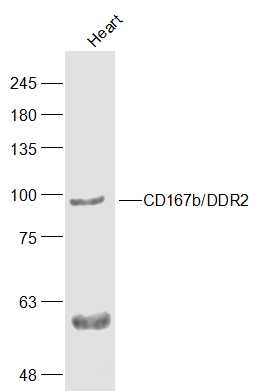
The image on the left is immunohistochemistry of paraffin-embedded Human thyroid cancer tissue using CSB-PA223476(DDR2 Antibody) at dilution 1/40, on the right is treated with synthetic peptide. (Original magnification: x200)
DDR2 Antibody
CSB-PA223476
ApplicationsELISA, ImmunoHistoChemistry
Product group Antibodies
ReactivityHuman, Mouse
TargetDDR2
Overview
- SupplierCusabio
- Product NameDDR2 Antibody
- Delivery Days Customer20
- ApplicationsELISA, ImmunoHistoChemistry
- CertificationResearch Use Only
- ClonalityPolyclonal
- ConjugateUnconjugated
- Gene ID4921
- Target nameDDR2
- Target descriptiondiscoidin domain receptor tyrosine kinase 2
- Target synonymsMIG20a, NTRKR3, TKT, TYRO10, WRCN, discoidin domain-containing receptor 2, CD167 antigen-like family member B, cell migration-inducing protein 20, discoidin domain receptor 2, discoidin domain receptor family, member 2, discoidin domain-containing receptor tyrosine kinase 2, hydroxyaryl-protein kinase, migration-inducing gene 16 protein, neurotrophic tyrosine kinase receptor related 3, receptor protein-tyrosine kinase TKT, tyrosine-protein kinase TYRO10
- HostRabbit
- IsotypeIgG
- Protein IDQ16832
- Protein NameDiscoidin domain-containing receptor 2
- Scientific DescriptionReceptor tyrosine kinases (RTKs) play a key role in the communication of cells with their microenvironment. These molecules are involved in the regulation of cell growth, differentiation, and metabolism. In several cases the biochemical mechanism by which RTKs transduce signals across the membrane has been shown to be ligand induced receptor oligomerization and subsequent intracellular phosphorylation. This autophosphorylation leads to phosphorylation of cytosolic targets as well as association with other molecules, which are involved in pleiotropic effects of signal transduction. RTKs have a tripartite structure with extracellular, transmembrane, and cytoplasmic regions. This gene encodes a member of a novel subclass of RTKs and contains a distinct extracellular region encompassing a factor VIII-like domain.
- ReactivityHuman, Mouse
- Storage Instruction-20°C or -80°C
- UNSPSC41116161






